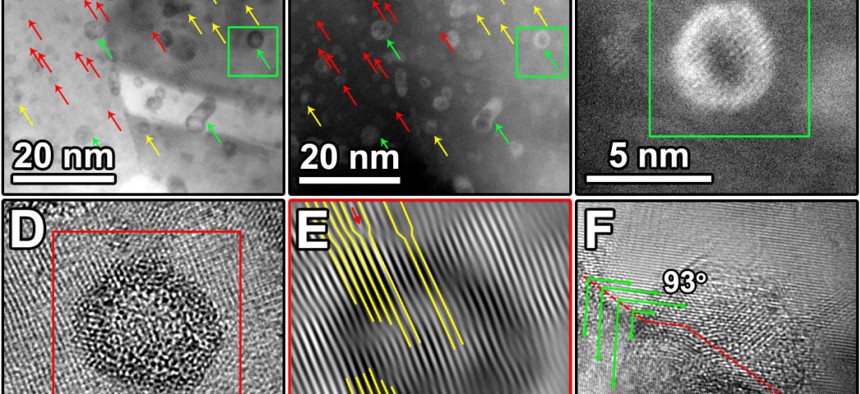
With military research into nanomaterials, the future looks light
Breakthrough work being led by the Army Research Lab and DARPA could revolutionize jet engines and microelectronics.
The military of the future, in addition to the well-known goal of being better connected, will also be a lot lighter, if current work by researchers comes to fruition. Lighter aircraft, for example, could be faster and more agile while requiring less fuel. As for the electronics carried, or worn, by troops in the field, the lighter the better.
Two examples involve breakthrough work being led by the Army Research Laboratory and the Defense Advanced Research Projects Agency, one involving nanomaterials that could boost engine technology, the other developing previously unattainable ultrathin materials by creating them at room temperature.
The ARL project is focusing on finding new materials that can withstand the heat levels—up to 2,500 degrees Fahrenheit—found in jet turbine engines. The research team managed to stabilize a copper alloy microstructure capable of resisting what’s called “creep response,” which refers to how materials lose their form under the stress of very high temperatures.
The result surprised researchers, to say the least. "What we're seeing is a revolutionary property arising in a class of materials that we never thought was possible," Dr. Kristopher A. Darling, a materials scientist with the laboratory's Lightweight and Specialty Metals Branch, said in an ARL release. "Normally this wouldn't happen," he said.
Darling acknowledged that copper isn’t typically the type of material that would be used in a turbine engine, but said, "If we could do this in other materials like nickel, cobalt or tantalum, it would definitely have a chance of revolutionizing engine technology.”
Darling, who with his team published the results earlier this month in Nature magazine, said that the initial results were so startling that he reached out to colleagues at the University of North Texas and Arizona State University for a second opinion. After some initial skepticism—the results were something that should not happen, according to what has been known in the burgeoning field of nanotechnology in metals—researchers saw the value in what was happening and the team set out on some more exhaustive studies.
"A lot of times unique discoveries are made by accident or by sheer luck, and this was one of those cases where we started to probe the material and we didn't see the response that we were expecting," Darling said.
The team plans to continue research toward maximizing the property, with an eye toward potentially revolutionizing engine technology, which Darling noted could have significant civilian as well as military applications.
DARPA, meanwhile, has been looking to lower the heat involved in synthesizing ultrathin materials, bringing what’s required for the process from 800 degrees Celsius (1,472 degrees F) down to room temperature.
That temperature requirement has prevented the development of thin-film microelectronics, because the heat caused many of the components to lose their functionality. The ability to perform the same process at room temperature could lead to new materials at the atomic level.
The process, called electron-enhanced atomic layer deposition (EE-ALD) was developed at the University of Colorado under the DARPA-led Local Control of Materials Synthesis, or LoCo, program.
The program kicked off in 2012 with the goal of finding low-temperature methods for creating thin films. CU’s research, conducted in collaboration with the Naval Research Laboratory and National Institute of Standards and Technology, has advanced to the point that researchers are now looking to scale the process to larger substrates, leading to significant advances in microelectronics.
“Looking forward, the EE-ALD approach could serve not just as a tool for integrating incompatible materials but also more generally to build and etch device architectures at atomic scales, an increasingly important capability as circuit geometries shrink,” said Tyler McQuade, DARPA program manager.

